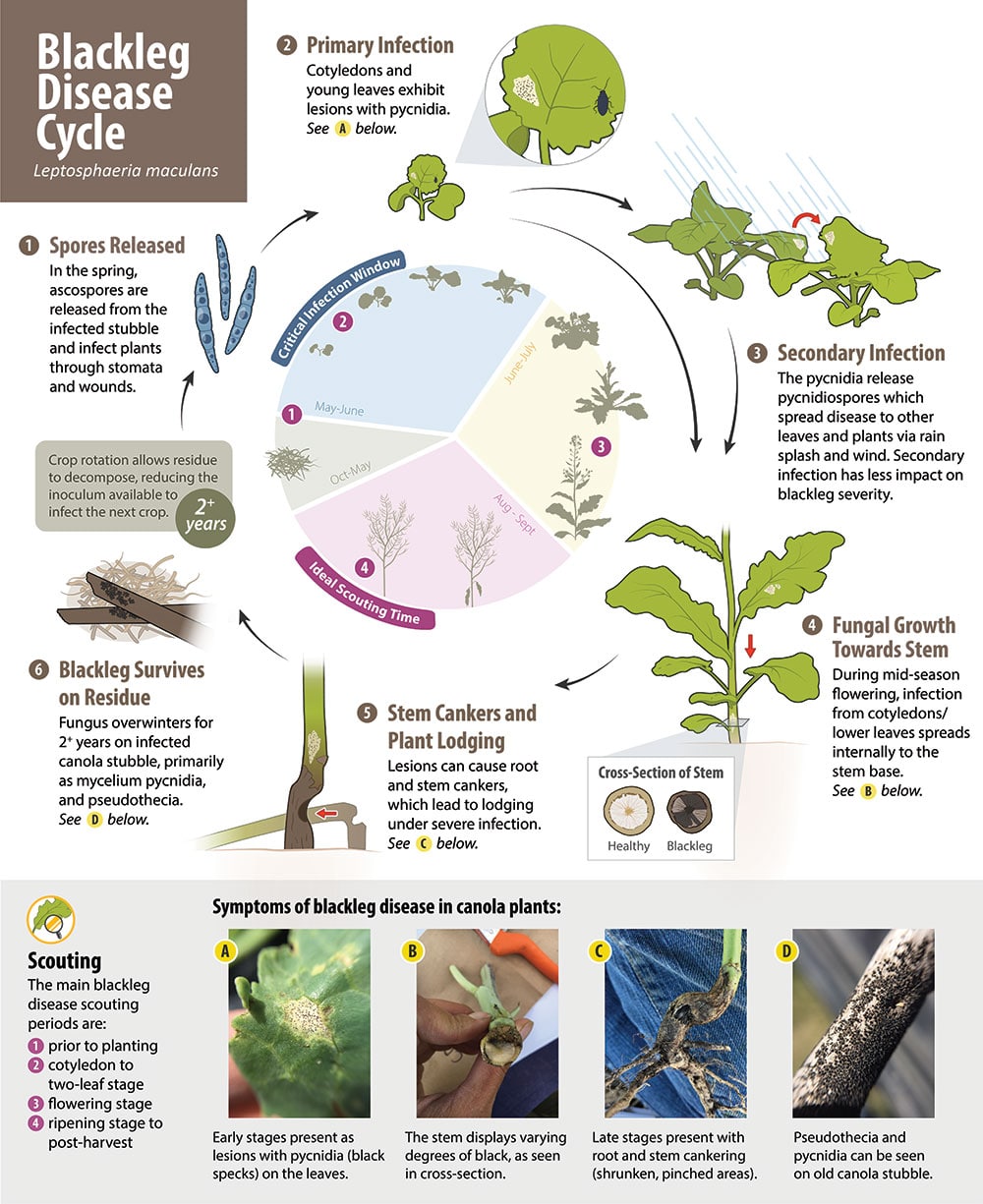New and Ongoing Projects
Plant establishment
A meta-analysis of small-plot trial data to examine the relationship between crop development and environmental conditions in canola
Principal investigator: Christiane Catellier, Indian Head Agriculture Research Foundation
Funding: SaskCanola, Western Grains Research Foundation
Objectives: Researchers will use archived small-plot canola agronomic trial data from across the canola production region and regional weather data to conduct a meta-analysis to examine the relationship between environmental conditions, canola emergence, and other crop development factors such as maturity and survivability. They will quantify the effect of specific environmental variables on canola emergence and subsequent
crop development.
Climate change resilience of Prairie oilseed crops and their below-ground microbiota under drought stress in controlled and field environments
Principal investigator: Tim Dumonceaux, AAFC Saskatoon
Funding: SaskCanola
Objectives: This project will examine the soil, rhizosphere, and root microorganisms that canola plants recruit under stress conditions. It will also isolate microbes (or groups of microbes) that could help plants adapt to changing conditions experienced on the Canadian Prairies.
Optimizing Crop Rotations to Enhance Agronomic, Economic and Environmental Performance
Principal investigator: Ramona Mohr, AAFC Brandon
Funding: Manitoba Canola Growers
Objectives: To determine the agronomic, economic and environmental performance of a range of crop rotations under Manitoba conditions, with a focus on wheat, canola, soybean and pea. Specifically, researchers will examine the effect of crop rotation (crop choice, crop sequence, and rotation duration) on crop yield and quality, disease incidence and severity, profitability and economic risk, soil health and nutrient cycling. The goal is to generate a reliable, research-based dataset of production and economic information for a range of climate smart cropping systems and crop rotations.
Understanding the effects of crop rotation on soil organic carbon stabilization
Principal investigator: Bobbi Helgason, University of Saskatchewan
Funding: SaskCanola, Saskatchewan’s Agriculture Development Fund, Western Grains Research Foundation, Sask Wheat
Objectives: To obtain new knowledge of the impact of crop rotation diversity on soil organic matter stability and functional pools, how long-term crop rotation diversity affects microbial abundance and activity, and the relationships between microbial community dynamics and functionally important pools of soil organic matter. The study will quantify carbon storage in different soil functional pools.
Fertility management
Using a 4Rs Plus approach to improve growth and sustainability of annual cropping systems in Saskatchewan
Principal investigator: Blake Weiseth, Discovery Farm
Funding: SaskCanola, Sask Wheat
Objectives: This study will assess the impact of 4R Nutrient Stewardship practices on nitrogen and phosphorus crop uptake and nutrient load in run-off water. It will also assess the impact of topography on nitrogen and phosphorus load in run-off water. Researchers will run a cost-benefit analysis of 4R and associated practices.
Richard Farrell (left) from the University of Saskatchewan works with Agriculture and Agri-Food Canada research scientist Reynald Lemke (right) on a number of fertilizer projects, including a new one called “Discovering the optimal rate of a dual-inhibitor N-fertilizer for maximum N2O emissions reduction.”
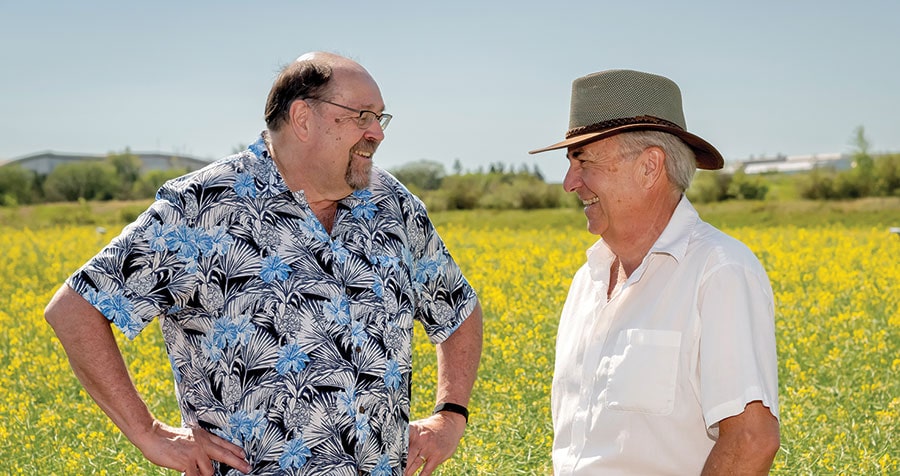
Climate-smart canola: quantifying soil- and fertilizer-derived nitrogen sources and greenhouse gas emissions under canola hybrids
Principal investigator: Melissa Arcand, University of Saskatchewan
Funding: SaskCanola, Alberta Canola, Manitoba Canola Growers
Objectives: This project will bring together physiological (plant-based; e.g. nitrogen harvest index) and agronomic (fertilizer-based; e.g. yield per unit nitrogen fertilizer) understanding of canola nitrogen use efficiency (NUE). Researchers will examine soil contributions to canola nitrogen fertility using 15N stable isotope tracing to paint a more complete picture of canola NUE. They will build on previous and current NUE research using a diverse set of canola genotypes to understand the range in NUE and the mechanisms underpinning NUE to identify breeding targets.
Tracing C and N during crop residue decomposition to optimize C sequestration and predict N transfer credit
Principal investigator: Bobbi Helgason, University of Saskatchewan
Funding: SaskCanola, Sask Wheat, SaskBarley
Objectives: Researchers aim to characterize the chemical composition of crop root and shoot tissues in wheat, barley, canola, lentil, field pea and soybean. The goal is to better understand plant residue factors—and residue by environment interactions —controlling decomposition. The result will be better assessment of the potential contribution of residue-nitrogen to the next crop. This could help to predict carbon and nitrogen transformations in the soil and develop farmer-friendly strategies to optimize soil carbon sequestration, organic matter accumulation and mitigate against nitrogen losses.
How does fall-applied nitrogen fertilizer influence soil-emitted nitrous oxide emissions during the over-winter and spring thaw period in the semi-arid Prairies?
Principal investigator: Reynald Lemke, AAFC Saskatoon
Funding: Alberta Canola
Objectives: Since N2O emissions are often a symptom of denitrification where nitrogen fertilizer is biologically converted to N2 gas, reducing N2O emissions also means a costs savings through greater nitrogen retention for crop use. This study will quantify soil-emitted N2O from soil receiving urea, dual-inhibitor urea or no nitrogen fertilizer during the non-growing season period under semi-arid conditions. It will examine factors driving the timing and magnitude of soil-emitted N2O during the non-growing season period and examine the impact of a dual-inhibitor urea product on soil microbial nitrifier and denitrifier dynamics.
Discovering the optimal rate of a dual-inhibitor N-fertilizer for maximum N2O emissions reduction
Principal investigator: Reynald Lemke, AAFC Saskatoon
Funding: SaskCanola, Saskatchewan’s Agriculture Development Fund, Western Grains Research Foundation, Sask Wheat
Objectives: Researchers will study how a dual inhibitor product applied at a reduced nitrogen-rate compares to urea. They will compare yields, and dig into the maximum N2O reduction that can be achieved with an DI fertilizer product while maintaining crop yields equivalent to a standard application rate of urea.
Evaluation of variable rate applied enhanced efficiency N fertilizers on wheat and canola- field scale management zones comparison
Principal investigator: Haben Tedla, AAFC Saskatoon
Funding: SaskCanola, Sask Wheat
Objectives: To evaluate the agronomic potential of variable-rate application and performance of enhanced efficiency nitrogen fertilizer. Researchers will compare the performance of SuperU, ESN-Urea blend and eNtrench to urea. They will conduct economic feasibility and risk assessment on sources of nitrogen fertilizer and on variable rate application by management zones.
Integrated pest management
Develop and assess different strategies to reduce the impact of pollen beetle Brassicogethes viridescens (Coleoptera: Nitidulidae), a new invasive insect pest on canola
Principal investigator: Christine Noronha, AAFC Charlottetown
Funding: Alberta Canola, Manitoba Canola Growers
Objectives: Pollen beetle, an invasive species, is a pest of rapeseed in Europe and has been found in canola in Eastern Canada. This project will evaluate the efficiency of different monitoring techniques to predict damage, evaluate canola cultivar preference by pollen beetles, survey fields in Alberta, Saskatchewan and Manitoba for pollen beetles, and survey for parasitoids in the Maritimes.
Deploying calcium-dependent protein kinases to fight canola pathogens
Principal investigator: Jacqueline Monaghan, Queen’s University
Funding: Alberta Canola, Manitoba Canola Growers, SaskCanola, Western Grains Research Foundation
Objectives: This project will use precision gene editing to enhance the function of single genes that could provide canola plants with enhanced, durable, broad-spectrum resistance to disease without any growth tradeoff. It will first select candidate Brassica napus calcium-dependent protein kinases (BnCPKs), then precision-engineer BnCPK alleles for enhanced disease resistance in canola.
Screening false cleavers from the Prairie Herbicide Resistance Surveys for quinclorac and glyphosate resistance
Principal investigator: Breanne Tidemann, AAFC Lacombe
Funding: Alberta Canola
Objectives: This project will provide an indication of how quickly quinclorac and glyphosate resistance in cleavers may be increasing or spreading on the Prairies. This will contribute to the development of technologies, strategies and recommendations that help growers mitigate or reduce selection pressure for weed resistance.
Breanne Tidemann, weed scientist with Agriculture and Agri-Food Canada in Lacombe, Alberta, collects buckwheat samples this fall for one of her many projects. She has a new canola research project screening false cleavers for quinclorac and glyphosate resistance.

Effects of heat and drought on canola – pollinator interactions and crop yield
Principal investigator: Shelley Hoover, University of Lethbridge
Funding: Alberta Canola
Objectives: Can pollinators improve canola yield when the crop is under heat and drought stress? Researchers will analyze the effects of heat and drought on seed yield and quality, with and without supplemental pollination by bees, for five varieties of canola. They will also examine the benefits of supplemental pollination prior to heat and drought stress versus at the time of the stress event (i.e. can yield be ‘rescued’ by bees?). Beekeepers will get information on independent and combined effects of drought and heat on nectar and pollen production in canola, across five varieties.
Biocontrol of blackleg using carnivorous bacteria
Principal investigator: Paul Holloway, University of Winnipeg
Funding: Manitoba Canola Growers
Objectives: This project will isolate various myxobacterial and mycophagous bacteria from soil, sediment, and plant material from Manitoba sources, then identify specific myxobacterial and mycophagous isolates. Researchers will determine whether the isolates can kill or inhibit the growth of filamentous fungi in general, then test them on Leptosphaeria maculans, the pathogen that causes blackleg in canola.
Updating the critical weed free period in canola
Principal investigator: Rob Gulden, University of Manitoba
Funding: SaskCanola, Alberta Canola, Manitoba Canola Growers, Alberta’s Results Driven Agriculture Research
Objectives: Herbicide labels indicate when it is biologically safe to apply the product but do not indicate when it is biologically necessary to prevent yield losses. Weed management thresholds and critical periods provide that information. This study will update the critical weed-free period (CWFP) for canola using modern canola hybrids, and determine how the crop’s plant density affects the CWFP. The goal is to collect data from sufficient locations and years to be able to make sound recommendations regarding the CWFP under various scenarios.
Balancing economic, action, and seed production thresholds for glyphosate-resistant kochia in canola
Principal investigator: Charles Geddes, AAFC Lethbridge
Funding: SaskCanola, Western Grains Research Foundation
Objectives: In Western Canada, glyphosate-resistant kochia is now more common than glyphosate-susceptible. Canola with stacked traits for both glyphosate and glufosinate tolerance can provide a management option. This project aims to determine the economic, action, and seed production thresholds for glyphosate-resistant kochia in canola planted at five versus 10 plants per square foot. Understanding these thresholds will aid in management decisions regarding a two-pass herbicide strategy in canola with stacked resistance to glyphosate and glufosinate, and further our understanding of the weed management implications of current canola stand density recommendations.
Continue monitoring Leptosphaeria maculans populations following the introduction of resistant genes Rlm2, Rlm4 and Rlm7 for effective resistance deployment on the Canadian Prairies
Principal investigator: Gary Peng, AAFC Saskatoon
Funding: SaskCanola, Alberta Canola, Western Grains Research Foundation
Objectives: It is generally believed that the blackleg pathogen population will adapt to the newly-introduced R genes, resulting in erosion in resistance over time. The proposed project is intended to provide updated information on pathogen race changes (Avr profile). Information on the prevalence and distribution of L. maculans races can help breeders determine effective regimes of R genes for new canola varieties. For agronomists, the information will help recommendations for optimal rotation of resistant canola cultivars. The study may also identify the emergence of virulent pathogen races, providing breeders and industry early warning before significant resistance erosion resulting from the defeat of Rlm2, Rlm4 or Rlm7. The study will also assess the impact of newly introduced R genes on blackleg in relation to the Avr profile of the pathogen at different locations.
Cover crops for flea beetle management
Principal investigator: Yvonne Lawley, University of Manitoba
Funding: Manitoba Canola Growers
Yvonne Lawley, research scientist at the University of Manitoba, leads a new project to evaluate the impact of overwintering and spring-planted cover crops on flea beetle damage of canola.
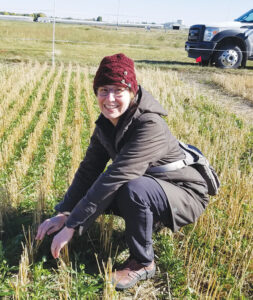
Objectives: This study will evaluate the impact of overwintering and spring-planted cover crops on flea beetle damage of canola. These preliminary experiments will not answer all questions but will verify previous observations under controlled conditions and identify the important questions, treatments, and measurements for expanded future research in this area. Analysis will consider trade-offs between the potential benefits of using cover crops to mitigate the risk of flea beetle damage and the practice’s possible impact on canola yield.
Comprehensive investigation of pesticides in honey, pollen, bees and soil collected from canola fields
Principal investigator: Elemir Simko, University of Saskatchewan
Funding: SaskCanola, Saskatchewan’s Agriculture Development Fund, MITACS
Objectives: This study will accurately document residues of 93 pesticides (including all neonicotinoids and their metabolites) in honey, pollen, bees and soil samples collected from canola fields and boreal regions across Saskatchewan. Honey, pollen, bees and soil will be collected before, during and after canola flowering. In addition, comparable samples will be collected from apiaries in northern Saskatchewan. Each sample will be subjected to a multi-residue analysis for 93 pesticide compounds. The evidence-based data will be useful for policy makers, canola producers, beekeepers, honeypackers and exporters, and consumers.
Harvest management
Quantifying combine auto-adjust capabilities in canola
Principal investigator: Lorne Grieger, Prairie Agricultural Machinery Institute
Funding: SaskCanola, Western Grains Research Foundation
Objectives: Data from this project will help identify differences in combine loss due to changes in ambient conditions and influenced by canola variety and harvest method. Researchers will measure the performance potential of combines with auto adjusting settings while harvesting canola. The goal is to understand the ability of using advanced control systems to reduce losses through changing conditions, and compare that to manually-set combines.
Genetics
Drought tolerance in canola through modulating the Kanghan gene family
Principal investigator: Zou Jitao, National Research Council
Funding: SaskCanola, Manitoba Canola Growers, Western Grains Research Foundation
Objectives: A gene family, Kanghan, which influences drought tolerance, was discovered though analysis of Arabidopsis ecotypes. This gene family was then identified in Brassica napus. Growth chamber assessment demonstrated that RNAi suppression of the Kanghan gene family in canola leads to drastically improved drought tolerance. This project will conduct CRISPR gene editing of the Kanghan genes in canola to generate knockout lines with improved drought tolerance. The primary objective is to demonstrate the Kanghan technology under field conditions so it could be adopted by industry programs for drought tolerance trait breeding.
Generation of canola lines with increased heat and drought tolerance by regulating phospholipid: diacylglycerol acyltransferase activity
Principal investigator: Guanqun (Gavin) Chen, University of Alberta
Funding: SaskCanola, Western Grains Research Foundation
Objectives: Recent extreme heat waves and arid conditions in Western Canada have led to catastrophic yield losses of canola in some areas. Phospholipid: diacylglycerol acyltransferase (PDAT1) catalyzes a terminal step of seed oil formation, and recent studies indicate that PDAT1 over-expression can effectively increase heat tolerance in the model plant Arabidopsis. This project will evaluate canola lines with distinct modifications of PDAT1 under heat and drought stress. It will also identify additional candidate genes related to heat and drought stress. Resulting characterized canola lines and genes could be used in breeding canola cultivars with improved heat and drought tolerance, as well as seed quality.
Functional validation of Brassica napus genes related to clubroot resistance through high-throughput CRISPR/CAS9 genome editing
Principal investigator: Wei Xiao, University of Saskatchewan
Funding: SaskCanola, Natural Sciences and Engineering Research Council
Objectives: Researchers will validate functions of clubroot resistance (CR) related genes and understand molecular mechanisms of clubroot resistance and susceptibility. They will establish a high-throughput CRISPR-Cas9-based gene editing platform in B. napus.
Modification of surface waxes for improved water retention in canola
Principal investigator: Mark Smith, AAFC Saskatoon
Funding: SaskCanola, Saskatchewan’s Agriculture Development Fund, Western Grains Research Foundation
Objectives: Surface wax functions as a barrier to water loss in plants. Researchers will study the positive or negative role of wax components in maintaining the cuticular water barrier of canola, and to identify DNA regions conferring epidermal transcription of genes. The ultimate goal will be to use a technique like genome editing to specifically prevent expression of target genes in the epidermis, without disrupting wax in other parts of the plant such as pollen.
Developing allele specific molecular markers for the B. napus blackleg resistance (Rlm) genes
Principal investigator: Hossein Borhan, Agriculture and Agri-Food
Canada Saskatoon
Funding: SaskCanola, Western Grains Research Foundation
Objectives: To sequence information for blackleg resistance genes Rlm1 and Rlm11 and PCR-based markers for these genes as well as Rlm2. This information will be publicly available for use by all seed companies, public and private research labs and private diagnostic labs.
Understanding the molecular basis of NLR-mediated clubroot resistance in Brassica napus
Principal investigator: Edel Pérez López, Université Laval
Funding: SaskCanola, Western Grains Research Foundation
Objectives: The goal is to identify clubroot-resistance genes of the nucleotide-binding leucine-rich repeat (NLR) family and characterize their mechanisms in existing commercial canola germplasm. Having identified candidate clubroot resistance genes, canola breeders will be able to incorporate such genes into their germplasm to test their function in combination with traditional marker-assisted breeding.
Ongoing Projects
Plant Establishment
Understanding grain pneumatic conveying in seeding equipment
Principal Investigator: Lorne Grieger, Prairie Agricultural Machinery Institute
Funding: SaskCanola, Ag Action Manitoba
Objectives: To look at factors in air seeder components that affect small seed distribution and viability, both in the field and in computer simulations.
How does in-row seed spacing and spatial pattern affect canola yield?
Principal Investigator: Steve Shirtliffe, University of Saskatchewan
Funding: SaskCanola
Objectives: To determine the optimum distance canola plants should have from their neighbour, both within rows and between rows, so they can survive to produce maximum yield at existing seeding rates.
Manipulating agronomic factors for optimum canola harvest timing, productivity and crop sequencing
Principal Investigator: Brian Beres, AAFC Lethbridge
Funding: Canadian Agricultural Partnership
Objectives: To look at the canola yield effect of seeding rates, hybrid maturity and harvest method.

Fertility management
Biological nitrogen fixation in canola
Principal Investigator: Alicia Ziemienowicz, Agriculture and
Agri-Food Canada Lethbridge
Funding: Alberta Canola, Alberta Innovates, Western Grains Research Foundation, Alberta’s Results Driven Agriculture Research
Objectives: To generate canola with the trait of “biological nitrogen fixation.” This trait would allow crops to grow more efficiently in nitrogen-deficient soil, making them independent of nitrogen fertilizers.
Understanding canola root morphology and microbiomes in response to soil phosphorus fertility
Principal Investigator: Bobbi Helgason, University of Saskatchewan
Funding: SaskCanola
Objectives: To determine how canola root architecture and the root-associated microbiome impact the plant’s ability to forage for phosphorus. This can help to develop strategies for overcoming phosphorus deficiency in canola production.
SKSIS-3: Synergies and Sustainability for the Saskatchewan Soil Information System
Principal Investigator: Angela Bedard-Haughn, University of Saskatchewan
Funding: SaskCanola, Western Grains Research Foundation, Growing Forward 2
Objectives: To enhance Saskatchewan Soil Information System (SKSIS) by developing and integrating predictive soil mapping tools into SKSIS, and by creating a standalone SKSIS feature for efficient use in internet-deficient areas.
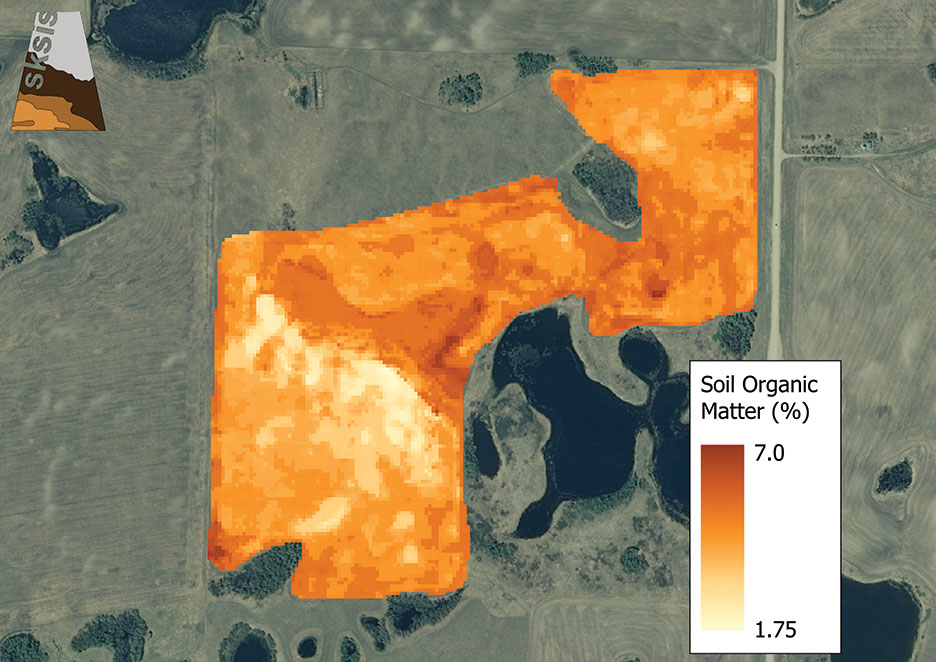
Revising the crop nutrient uptake and removal guidelines for Western Canada
Principal Investigator: Fran Walley, University of Saskatchewan
Funding: SaskCanola, Western Grains Research Foundation,
other commodity groups
Objectives: To determine and revise estimates of the nutrient uptake and removal of crops commonly grown in Western Canada, and to develop a user-friendly online and mobile app for determining nutrient uptake and removal estimates.
Using Modulated On-farm Response Surface Experiments (MORSE) to develop evidence based, agronomic recommendations
Principal Investigator: Steve Shirtliffe, University of Saskatchewan
Funding: SaskCanola, Sask Wheat, Western Grains Research Foundation
Objectives: To develop methodology that will allow crop input experiments to be performed using Modulated On-farm Response Surface Experiments, to refine image-based technology as a tool to assess crop response variables, including yield.
Enhancing the Saskatchewan Soil Health Assessment Protocol – Phase 2
Principal Investigator: Kate Congreves, University of Saskatchewan
Funding: SaskCanola, Sask Wheat
Objectives: To build on the Saskatchewan Soil Health Testing Protocol so that it outputs soil zone-specific scores; to incorporate novel microbial measurements of soil health into the testing protocol; and to explore early-indicators of soil health change.
Shining a light on digital agriculture: Linking soil NIR measurements, fertility and crop yields
Principal Investigator: Derek Peak, University of Saskatchewan
Funding: SaskCanola, Sask Wheat, Saskatchewan’s Agriculture
Development Fund
Objectives: To use spectral sensing to produce spatially-resolved soil based yield potential maps; and develop methodology to link field near infrared (NIR) data and laboratory analyses.
Impact of phosphorus fertilizer forms on nutrition of wheat, pea and canola, soil fate and losses in run-off water
Principal Investigator: Jeff Schoenau, University of Saskatchewan
Funding: SaskCanola, Sask Wheat, SaskPulse, Western Grains Research Foundation
Objectives: To assess how phosphorus fertilizer forms, placement, and rate affect crop responses, fate in the soil, and run-off losses in Saskatchewan soils.
Improving nitrogen use efficiency and soil sustainability in canola production across Canada
Principal Investigator: Bao-luo Ma, AAFC Ottawa
Funding: Canadian Agricultural Partnership
Objectives: To assess and improve nitrogen use efficiency (NUE); to identify root architecture traits for efficient nitrogen acquisition; and to investigate how the soil microbiome responds to nitrogen management.
Collecting the carbon data needed for climate-smart agriculture in Saskatchewan
Principal Investigator: Kate Congreves, University of Saskatchewan
Funding: SaskCanola, Sask Wheat, SaskOats, Saskatchewan’s Agriculture Development Fund
Objectives: To provide year-round measurements of greenhouse gas emissions from a representative cropping system in Saskatchewan; to assess 4R practices to minimize carbon footprints; to test if Saskatchewan cropping systems are a net carbon sink.
Integrated pest management – Disease
The role of insect feeding and plant defense responses in aster yellows disease epidemiology
Principal Investigator: Sean Prager, University of Saskatchewan
Funding: Alberta Canola, Manitoba Canola Growers
Objectives: To quantify the feeding behaviour of aster leafhoppers on different host plants and examine the relationship between feeding time and aster yellows phytoplasma.
Investigating interactions of ascospores and pycidiospores with blackleg resistance in canola and efficacy of seed applied fungicides
Principal Investigator: Dilantha Fernando, University of Manitoba
Funding: SaskCanola
Objectives: To develop a protocol to efficiently produce ascospore and pycnidiospore inoculum with defined Avr profile for resistance screening. To assess interactions of inoculum types with blackleg resistance. To evaluate seed-applied fungicides.
Purifying genotypes of P. brassicae and developing markers linked to races of P. brassicae collected in Western Canada
Principal Investigator: Fengqun Yu, AAFC Saskatoon
Funding: SaskCanola, Manitoba Canola Growers, Western Grains Research Foundation
Objectives: To develop markers linked to races of P. brassicae (the pathogen that causes clubroot), similar to the technology used for blackleg. First step is an efficient method to produce near pure genotype isolates (NPGI).
Influence of pH on the clubroot pathogen: are there pH-insensitive strains?
Principal Investigator: Stephen Strelkov, University of Alberta
Funding: Alberta Canola, SaskCanola, Manitoba Canola Growers
Objectives: To determine whether strains of the clubroot pathogen respond differentially to soil pH and whether pathogen strains can become adapted to high pH conditions.
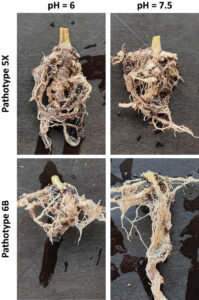 Some clubroot pathotypes can infect at higher soil pH. University of Alberta researcher Stephen Strelkov leads a study called “Influence of pH on the clubroot pathogen: are there pH-insensitive strains?” to look into these differences. The photo shows symptoms caused by clubroot pathotype 5X at pH 6 (susceptible host reaction) and pH 7.5 (susceptible host reaction), and symptoms caused by clubroot pathotype 6B at pH 6 (susceptible host reaction) and pH 7.5 (partially resistant host reaction). The isolate representing pathotype 6B is more sensitive to higher pH than the isolate representing 5X.
Some clubroot pathotypes can infect at higher soil pH. University of Alberta researcher Stephen Strelkov leads a study called “Influence of pH on the clubroot pathogen: are there pH-insensitive strains?” to look into these differences. The photo shows symptoms caused by clubroot pathotype 5X at pH 6 (susceptible host reaction) and pH 7.5 (susceptible host reaction), and symptoms caused by clubroot pathotype 6B at pH 6 (susceptible host reaction) and pH 7.5 (partially resistant host reaction). The isolate representing pathotype 6B is more sensitive to higher pH than the isolate representing 5X.
Clubroot inoculum management for sustainable canola production
Principal Investigator: Stephen Strelkov, University of Alberta
Funding: Alberta Canola, Alberta Agriculture, Forestry and Rural
Economic Development
Objectives: To determine the spore population levels that are safe for the use of clubroot-resistant cultivars and develop a knowledge-based resistance deployment strategy.
A rapid molecular assay to identify Plasmodiophora brassicae pathotypes from plant and soil samples
Principal Investigator: Stephen Strelkov, University of Alberta
Funding: Alberta Canola, Alberta Agriculture, Forestry and Rural Economic Development
Objectives: To generate an effective rapid molecular assay (PCR-based) to identify abundance and diversity of P. brassicae pathotypes in soil and plant samples; and to use genetic variability among pathotypes to identify genes of interest related to infection.
Study of the effects of Brassica root architecture and fertilizer application on clubroot disease severity
Principal Investigator: Stephen Strelkov, University of Alberta
Funding: Alberta Canola, Western Grains Research Foundation, Results Driven Agriculture Research
Objectives: To investigate the association between Brassica root architecture and nitrogen treatments on clubroot severity and crop yield.
Fine-tuning of the blackleg yield loss model in canola
Principal Investigator: Stephen Strelkov, University of Alberta
Funding: Canadian Agricultural Partnership
Objectives: To refine and improve on an earlier yield loss model by using modern hybrid cultivars.
Understanding fusarium wilt and root rot of hybrid canola
Principal Investigator: Sheau-Fang Hwang, University of Alberta
Funding: Alberta Canola, Results Driven Agriculture Research
Objectives: To optimize cultural methods to control the fusarium pathogens causing seedling blight and root rot and wilt of canola.
Exploring novel seed-treatment options to mitigate the impact of blackleg on canola
Principal Investigator: Gary Peng, AAFC Saskatoon
Funding: SaskCanola, Alberta Canola, Manitoba Canola Growers
Objectives: To assess the importance of blackleg infection from the soil, and investigate the conditions that affect the success of infection. The information will help understand the potential value of fungicide seed treatment for blackleg.
Monitoring the race dynamics of Leptosphaeria maculans for effective deployment and rotation of resistance genes for sustainable management
of blackleg
Principal Investigator: Gary Peng, AAFC Saskatoon
Funding: SaskCanola, Alberta Canola, Manitoba Canola Growers
Objectives: To provide an up-to-date L. maculans race profile, which can be used to guide the deployment or rotation of canola cultivars carrying different R genes. To see how pathogen race changes in response to resistant cultivars over the years.
Improving management of blackleg on canola via better flea beetle control and effective fungicide seed treatment in Western Canada
Principal Investigator: Gary Peng, AAFC Saskatoon
Funding: Canadian Agricultural Partnership
Objectives: To assess potential connection between flea beetle feeding and blackleg infection, and whether foliar insecticide, blackleg-resistant cultivar and fungicide seed treatment can alleviate blackleg infection under different flea beetle feeding pressure.
Developing a robust system for efficient assessment of quantitative resistance (QR) in commercial canola varieties for blackleg management
Principal Investigator: Gary Peng, AAFC Saskatoon
Funding: Canadian Agricultural Partnership
Objectives: To explore a ddPCR-based protocol to measure quantitative resistance (QR) to blackleg in canola. Once developed and validated, this can quantify QR in canola cultivars and help screen QR traits in commercial canola breeding lines.
Understanding the critical infection window that causes blackleg of canola in Western Canada
Principal Investigator: Gary Peng, AAFC Saskatoon
Funding: Canadian Agricultural Partnership
Objectives: To understand how quantitative resistance (QR) affects the success of stem infection via cotyledons or lower true leaves. The information may help fine-tune the timing of fungicide, including use of seed treatment.
Managing small patches of clubroot infestation in canola fields
Principal Investigator: Bruce Gossen, AAFC Saskatoon
Funding: Alberta Canola, SaskCanola, Manitoba Canola Growers
Objectives: To develop practical recommendations to manage small patches of clubroot. Includes lab studies of rotation crops and grass cover crops, field studies of liming and grasses, and tests to estimate resting spore numbers in soil.
Developing single-spore isolates of pathotypes of Plasmodiophora brassicae
Principal Investigator: Bruce Gossen, AAFC Saskatoon
Funding: SaskCanola, Saskatchewan’s Agriculture Development Fund
Objectives: To develop techniques for whole-genome sequencing of single spores of P. brassicae, the pathogen that causes clubroot.
Clubroot Pillar 3: Host-pathogen biology and interaction
Principal Investigator: Bruce Gossen, AAFC Saskatoon
Funding: Canadian Agricultural Partnership
Objectives: To examine factors that affect resting spore survival, germination and infection; to examine quantitative resistance to see if it might increase the durability of resistance genes; and to evaluate strategies to maximize the durability of resistance.
Application of hyperspectral imaging for detection and mapping of small patch clubroot infestations in commercial canola fields
Principal Investigator: David Halstead, Saskatchewan Polytechnic
Funding: SaskCanola, Saskatchewan’s Agriculture Development Fund
Objectives: To identify readily applied diagnostic features for mapping small clubroot patches and develop a diagnostic tool; to refine and validate diagnostic tool for identifying small patch clubroot infestations.
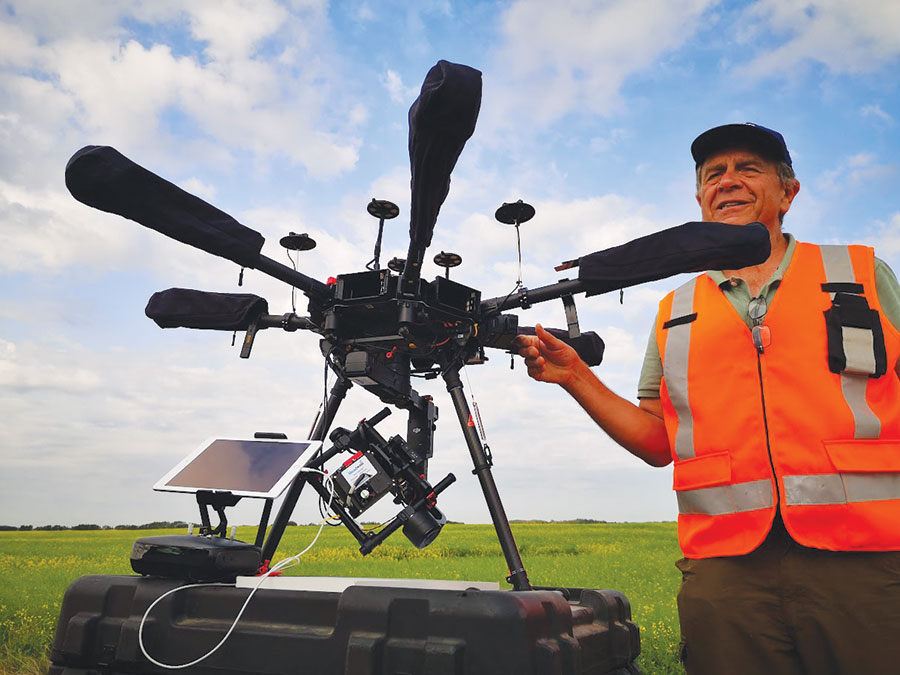
A proteomics-based approach towards identifying host and pathogen proteins critical to clubroot establishment in canola
Principal Investigator: Chris Todd, University of Saskatchewan
Funding: SaskCanola, Western Grains Research Foundation
Objectives: To identify P. brassicae effector proteins and to identify differentially expressed proteins in clubroot-susceptible and clubroot-resistant canola lines.
Biopesticides as a novel management strategy for sclerotinia in canola
Principal Investigator: Susan Boyetchko, AAFC Saskatoon
Funding: SaskCanola, Manitoba Canola Growers
Objectives: To screen and evaluate the biopesticide potential of selected bacterial strains that are indigenous to the Canadian Prairies and determine their ability to control disease development and growth of Sclerotinia sclerotiorum in canola.
Resistance to Sclerotinia sclerotiorum effectors in canola
Principal Investigator: Dwayne Hegedus, AAFC Saskatoon
Funding: Canadian Agricultural Partnership
Objectives: To simplify the identification of Brassica napus canola lines with tolerance to sclerotinia stem rot.
Development of a biosensor for sclerotinia stem rot disease forecasting in canola
Principal Investigator: Xiujie (Susie) Li, InnoTech Alberta
Funding: Canadian Agricultural Partnership
Objectives: To develop an in-field real-time sensor to monitor plant disease pathogens, specifically the sclerotinia stem rot pathogens. The sensor would notify the farmer, via cell phone, when a disease outbreak is imminent.
Improving the management of sclerotinia stem rot of canola using fungicides and better risk assessment tools
Principal Investigator: Kelly Turkington, AAFC Lacombe
Funding: Canadian Agricultural Partnership
Objectives: To study how the relationship between inoculum availability and environmental conditions before and during flowering impacts stem rot risk and fungicide response; to study how crop development and variability in flowering impact fungicide efficacy; and to test fungicide application timing.
Verticillium stripe – The disease management
Principal Investigator: Sheau-Fang Hwang and Stephen Strelkov, University of Alberta
Funding: Alberta Canola, SaskCanola, Manitoba Canola Growers
Objectives: To determine the effects of growth stage and inoculation techniques on host infection, and to evaluate the effects of disease severity on plant growth and yield at different inoculum concentrations.
Verticillium disease etiology and nursery
Principal Investigator: Dilantha Fernando, University of Manitoba
Funding: Canadian Agricultural Partnership
Objectives: To identify and characterize Verticillium longisporum isolates from across the Prairies; to investigate the longevity of micro-sclerotia in canola stems, and monitor pathogen movement in soil or through space; and to look for resistant canola lines.
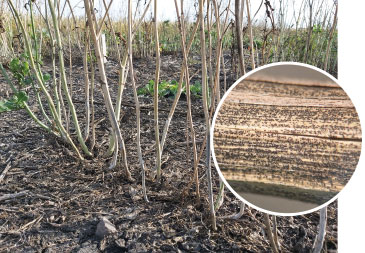
Genetics and genomics of Brassica-Verticillium interaction
Principal Investigator: Hossein Borhan, Agriculture and Agri-Food Canada Saskatoon
Funding: Canadian Agricultural Partnership
Objectives: To identify verticillium-resistant (canola) lines and to develop pathogen diagnostic tools.
Protection of canola from pathogenic fungi using RNA interference technologies
Principal Investigator: Steve Whyard, University of Manitoba
Funding: Canadian Agricultural Partnership
Objectives: To synthesize double-stranded RNA (dsRNA) and screen for fungicidal activity on sclerotinia stem rot and non-target effects, develop and test topical formulations, and assess the persistence of dsRNAs in the soil.
Integrated pest management – Insects
Insecticide susceptibility and resistance monitoring of flea beetles in canola
Principal Investigator: Boyd Mori, University of Alberta
Funding: Alberta Canola, Western Grains Research Foundation, Results Driven Agriculture Research
Objectives: To determine the susceptibility of the striped and crucifer flea beetle to various registered insecticides and investigate the mechanisms of insecticide tolerance.
Monitoring the canola flower midge within pheromone-baited traps
Principal Investigator: Boyd Mori, University of Alberta
Funding: Western Grains Research Foundation, Alberta Canola, SaskCanola, Manitoba Canola Growers
Objectives: To develop a pheromone-monitoring tool for the canola flower midge and enhance our knowledge of the factors that contribute to its pest status.
Identifying key predators and their role in canola insect pest suppression
Principal Investigator: Boyd Mori, University of Alberta
Funding: Alberta Canola, Manitoba Canola Growers, Western Grains
Research Foundation
Objectives: To identify the key natural enemies in the canola agroecosystem by detecting pest insect DNA in guts of predators, and to begin quantifying their pest suppression ability.
Evaluating the effect of canola seeding rate and seed size seeded into wheat stubble on flea beetle damage and population
Principal Investigator: María Angélica Ouellette, North Peace Applied Research Association
Funding: Alberta Canola
Objectives: To evaluate the impact of seeding rate, seed size, and seeding date on flea beetle damage – specifically for the North Peace region.
Continuing to watch the winds: the origin and arrival of migrant aster leafhoppers and diamondback moths
Principal Investigator: Tyler Wist, AAFC Saskatoon
Funding: SaskCanola, Western Grains Research Foundation
Objectives: To pinpoint the southern origins of diamondback moth and aster leafhopper; to see if alfalfa could be a “green bridge” for aster yellows phytoplasma in Saskatchewan; to develop aster yellows risk index.
Surveillance networks for beneficial Insects II
Principal Investigator: Paul Galpern, University of Calgary
Funding: Alberta Canola, Manitoba Canola Growers
Objectives: To determine how far services extend from beneficial anthropod reservoirs and how much beneficial anthropod reservoirs contribute to canola yield by using precision agriculture.
Integrated approaches for flea beetle control II
Principal Investigator: Alejandro Costamagna, University of Manitoba
Funding: Canadian Agricultural Partnership
Objectives: To improve flea beetle management in general by studying the effect of plant density in flea beetle management, the effect of stem feeding damage, the role of natural enemies on flea beetle management, and regional predictive models for flea beetle abundance.
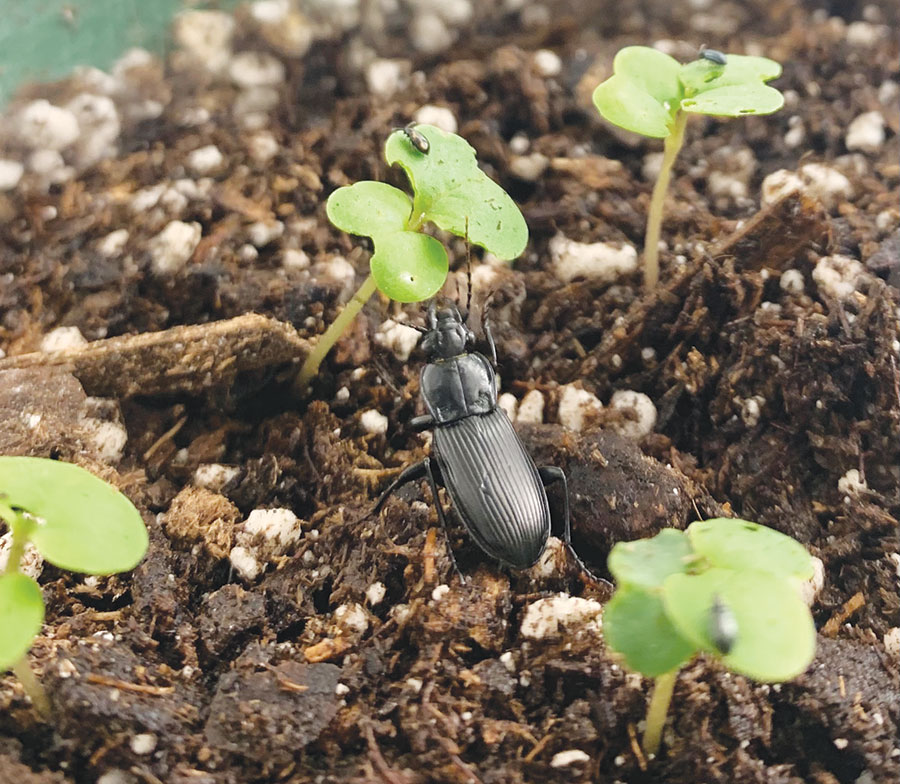
Genetic resources for flea beetle resistance in canola
Principal Investigator: Dwayne Hegedus, AAFC Saskatoon
Funding: Canadian Agricultural Partnership
Objectives: To investigate the complexity of the “hairy” trait and will provide canola breeders with hairy lines, and associated genetic markers, to allow its introduction into canola varieties.
Biological control of cabbage seedpod weevil in the Prairies
Principal Investigator: Hector Carcamo, AAFC Lethbridge
Funding: Canadian Agricultural Partnership
Objectives: To assess the efficacy of T. perfectus in managing seedpod weevil in Quebec and its non-target effects in Eastern Canada. To document the species of weevils and parasitoids in cultivated and uncultivated habitats that could be affected directly or indirectly in the Prairies.
Exploring further possibilities and advancements of using bio-control entomopathogenic nematodes (EPNs)
Principal Investigator: Shabeg Briar, Olds College
Funding: Alberta Canola, Results Driven Agriculture Research
Objectives: To assess the management of root maggots and cutworms using commercially available entomopathogenic nematodes (EPNs); to identify and explore locally adapted virulent strains of EPNs.
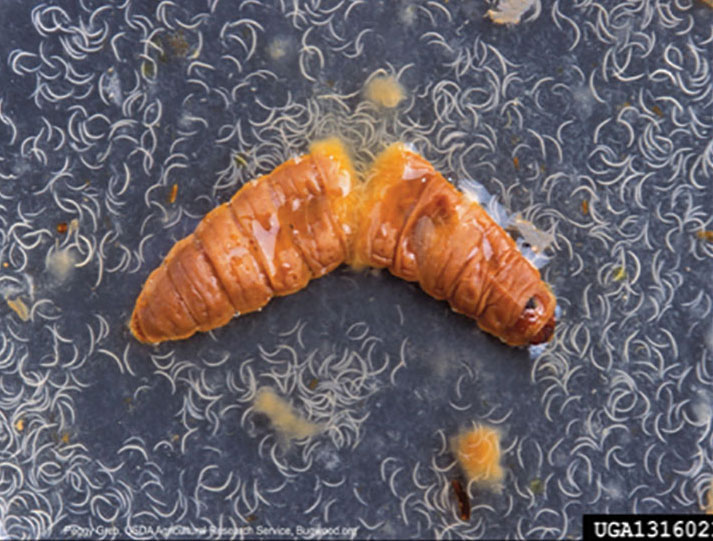
Incorporation of abiotic and biotic factors for development of stage-structured predictive models of flea beetles
Principal Investigator: Maya Evenden, University of Alberta
Funding: Alberta Canola, Results Driven Agriculture Research
Objectives: To develop a weather-dependent, stage-structured deterministic developmental model for both flea beetle species and evaluate appropriate base temperature thresholds for predictions of flea beetles in canola.
Integrated Pest Management – weeds
Herbicide resistant kochia and Russian thistle prairie surveys
Principal investigator: Julia Leeson, AAFC Saskatoon; Andrew Sharpe, Global Institute for Food Security
Funding: Western Grains Research Foundation, SaskCanola and other commodity groups
Objectives: To determine the distribution and abundance of glyphosate-resistant or auxinic-resistant kochia and other targeted weeds, including Russian thistle, waterhemp, and ragweed species in Manitoba, Saskatchewan and Alberta.
Prairie weed surveys
Principal investigator: Julia Leeson, AAFC Saskatoon; Andrew Sharpe, Global Institute for Food Security
Funding: Western Grains Research Foundation, SaskCanola and other commodity groups
Objectives: To complete the sixth set of weed surveys in the Prairie Provinces since the series of provincial surveys began in the mid-1970s. To summarize existing weed survey information and conduct a new series of general weed surveys.
Enhance understanding of cleavers populations in western Canada
Principal investigator: Breanne Tidemann, Agriculture and Agri-Food Canada Lacombe
Funding: Alberta Canola, SaskCanola, Western Grains Research Foundation
Objectives: To look for cleavers biotypes on the Prairies based on emergence phenology, whorl/branch number, seed production, and seed weight. Evaluate emergence timing of cleavers populations. Screen for quinclorac resistance.
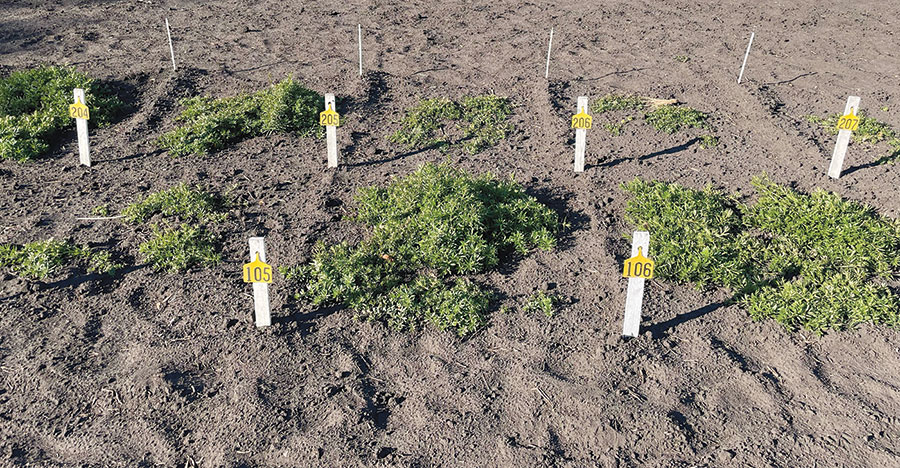
Manipulating weed seed production through phenology-based weed control
Principal investigator: Charles Geddes, AAFC Lethbridge
Funding: Alberta Canola, Alberta Wheat Commission, Sask Wheat, Western Grains Research Foundation
Objectives: To improve our understanding of weed phenology in Western Canada, and use that information to develop strategies to reduce the amount of weed seed returned to the soil. This will help with herbicide-resistant weed management.
Integrated Pest Management – other
Impact of drought and heat during flowering on canola yield
Principal investigator: Raju Soolanayakanahally, Agriculture and Agri-Food Canada Saskatoon
Funding: SaskCanola, Saskatchewan’s Agriculture Development Fund
Objectives: To see how drought, heat and a combination of the two can affect canola seed yield, oil composition and carbon assimilation.
Promotion of Wetland Stewardship Best Management Practices Through a Targeted Water Monitoring Project
Principal investigator: Tony Ciarla, Millenium EMS Solutions
Funding: Alberta Canola and various other public and private funders
Objectives: To evaluate wetland management practices in mitigating the movement of crop protection products into wetlands and aquatic ecosystems. This will help ensure that farmers have access to crop protection tools by continuing to follow sound environmental stewardship.
Genetics
Contribution of individual defence genes to sclerotinia resistance in canola
Principal investigator: Lone Buchwaldt, AAFC Saskatoon
Funding: SaskCanola, Saskatchewan’s Agriculture Development Fund
Objectives: To determine the contribution of lectin genes to sclerotinia resistance in canola, to determine the contributio of penetration-resistance genes to sclerotinia resistance in canola, and to determine the contribution of other candidate defense genes to sclerotinia resistance in canola.
Preserving hybrid vigour through a novel apomixis breeding strategy in Brassica crops
Principal investigator: Tim Sharbel, University of Saskatchewan
Funding: SaskCanola, Saskatchewan’s Agriculture Development Fund
Objectives: To generate diploid, hybrid unbalanced apomictic boechera backcrosses; to transfer apomixis from these lines into sexual bridging species; and to generate apomictic brassica crops via intergeneric crosses.
Modified lipid metabolism to deliver improved low temperature tolerance in Brassica napus
Principal investigator: Mark Smith, AAFC Saskatoon
Funding: SaskCanola, Saskatchewan’s Agriculture Development Fund
Objectives: To apply a targeted approach to identify new traits to confer improved low temperature tolerance in seedling canola.
Establishing transgene-free CRISPR/Cas9 based genome editing platform to improve canola resistance to clubroot
Principal investigator: Wei Xiao, University of Saskatchewan
Funding: SaskCanola, Saskatchewan’s Agriculture Development Fund
Objectives: To establish transgene-free CRISPR/Cas9 based genome editing platform to support canola breeding programs, to identify novel clubroot resistance genes and create novel resistance allelic variants in elite canola germplasms.
Increasing abiotic (drought) and biotic (clubroot) resistance in Brassica species by modifying auxin response
Principal investigator: Jocelyn Ozga, University of Alberta
Funding: SaskCanola, Alberta Canola, Natural Sciences and Engineering
Research Council
Objectives: To develop novel genetically-improved canola, using a biotechnological approach, that is more resistant to both biotic (clubroot disease) and abiotic (drought) stress.
Improving heat and drought resistance in canola through regulating DGAT1 activity
Principal investigator: Gavin Chen, University of Alberta
Funding: Alberta Canola
Objectives: To generate and evaluate canola lines with distinct modifications of DGAT1 enzyme under heat and drought stress and to identify additional candidate genes related to heat and drought stress. Diacylglycerol acyltransferase 1 (DGAT1) can increase tolerance to drought, heat or freezing stress in arabidopsis.
Identification and exploitation of genome structural variants for trait improvement in Prairie crops
Principal investigator: Andrew Sharpe, Global Institute for Food Security
Funding: SaskCanola, Sask Wheat, Alberta Wheat, Western Grains
Research Foundation
Objectives: To develop canola and wheat pan-genome structural variant (PanSV) atlases; to develop high-throughput structural variant (SV) genotyping pipeline; to associate SVs with important agronomic traits.
Exploring Brassica oleracea for resistance to the newly emerged P. brassicae pathotypes
Principal investigator: Habibur Rahman, University of Alberta
Funding: Alberta Canola, Alberta Agriculture & Forestry
Objectives: To introgress clubroot resistance genes from the cabbage/cauliflower-type plant species (B. oleracea) into Canadian canola, and develop molecular markers for these genes.
Improvement of the clubroot-resistant canola germplasm of canola × rutabaga cross, and fine mapping of the resistance gene
Principal investigator: Habibur Rahman, University of Alberta
Funding: Alberta Canola, Alberta Innovates, Alberta Agriculture & Forestry
Objectives: To develop canola lines that carry the clubroot resistance gene of rutabaga, resulting in clubroot-resistant hybrid canola cultivars.
Introgression of clubroot resistance from B. rapa into B. napus canola and identification of molecular markers for resistance
Principal investigator: Habibur Rahman, University of Alberta
Funding: Alberta Canola, SaskCanola
Objectives: To introgress clubroot resistance (CR) from B. rapa to canola.
The B. rapa germplasm used in this research carries resistance to pathotypes 3 and 3A. This could be a new source of resistance.
Re-synthesizing Brassica napus with clubroot resistance from C-genome
Principal investigator: Fengqun Yu, AAFC Saskatoon
Funding: Alberta Canola, Alberta Innovates
Objectives: To generate new and unique germplasm and make it available to canola breeders to develop cultivars with broad spectrum of resistance to clubroot in Western Canada.
Genetic dissection of the RLM3-4-7-9 blackleg R gene cluster and KASP marker improvement
Principal investigator: Hossein Borhan, AAFC Saskatoon
Funding: Canadian Agricultural Partnership
Objectives: To identify the Rlm3, 4, 7, 9 genes for resistance against blackleg, develop allele specific markers B. napus donor lines for canola breeding and understand the function of these genes.
From field to the genome. Application of 3rd generation sequencing to direct genotyping of canola pathogens
Principal investigator: Hossein Borhan, AAFC Saskatoon
Funding: Alberta Canola, SaskCanola
Objectives: To help canola growers with management of clubroot disease, researchers propose to develop a sensitive and rapid diagnostic tool to detect the presence of pathogen and determine the pathotypes present and the relative abundance.
Overcoming blackleg disease in canola through establishment of quantitative resistance
Principal investigator: Hossein Borhan, AAFC Saskatoon
Funding: SaskCanola
Objectives: To clone adult plant resistance (APR) genes against blackleg disease, to characterize the host pathways triggered by these genes, and to incorporate APR genes into commercial canola cultivars by marker-assisted breeding and gene editing.
Developing tools for the rapid screening of canola germplasm for quantitative resistance to blackleg disease
Principal investigator: Hossein Borhan, AAFC Saskatoon
Funding: Canadian Agricultural Partnership
Objectives: To optimize a protocol for identifying adult plant resistance (APR) to blackleg disease under controlled conditions and validate results in the field; to develop molecular markers associated with APR genes.
To standardize the nomenclature of blackleg resistance genes
Principal investigator: Hossein Borhan, AAFC Saskatoon
Funding: Alberta Canola, SaskCanola
Objectives: To help in the international effort to locate new blackleg resistance genes, researchers need a universal protocol so they’re not finding the same gene multiple times but giving it different names – which is happening.
Developing tools for the rapid screening of canola germplasm for quantitative resistance to disease
Principal investigator: Hossein Borhan, AAFC Saskatoon
Funding: Canadian Agricultural Partnership
Objectives: To develop a protocol to screen for quantitative resistance to blackleg in canola germplasm under controlled environmental conditions in growth chambers.
Weeding Out Secondary Dormancy Potential From Volunteer Canola
Principal investigator: Sally Vail, AAFC Saskatoon
Funding: Canadian Agricultural Partnership
Objectives: To look for the genomic regions harbouring the genes controlling secondary dormancy in Brassica napus; to identify molecular markers to facilitate selection; to scan B. napus lines for lower secondary dormancy, perhaps identifying parent lines less likely to become volunteers.
Pre-breeding lines combining canola quality with sclerotinia resistance, good agronomy and genomic diversity from PAK93
Principal investigator: Sally Vail, AAFC Saskatoon
Funding: Western Grains Research Foundation, Alberta Canola, Manitoba Canola Growers, SaskCanola
Objectives: To develop resistant pre-breeding lines that combine desirable traits in PAK93 with canola seed quality and shatter resistance from Agriculture and Agri-Food Canada’s elite lines; to form a consortium of breeding companies interested in funding final selection of pre-breeding lines.
Addressing yield stability drivers of canola in a changing climate using high throughput phenotyping
Principal investigator: Sally Vail, AAFC Saskatoon
Funding: Western Grains Research Foundation, Manitoba Canola Growers, SaskCanola
Objectives: To fund field trials of the B. napus nested association mapping (NAM) germplasm resource in contrasting climatic environments. This will provide a sufficient datatset to test and apply phenotyping and selection techniques to improve canola yield stability.
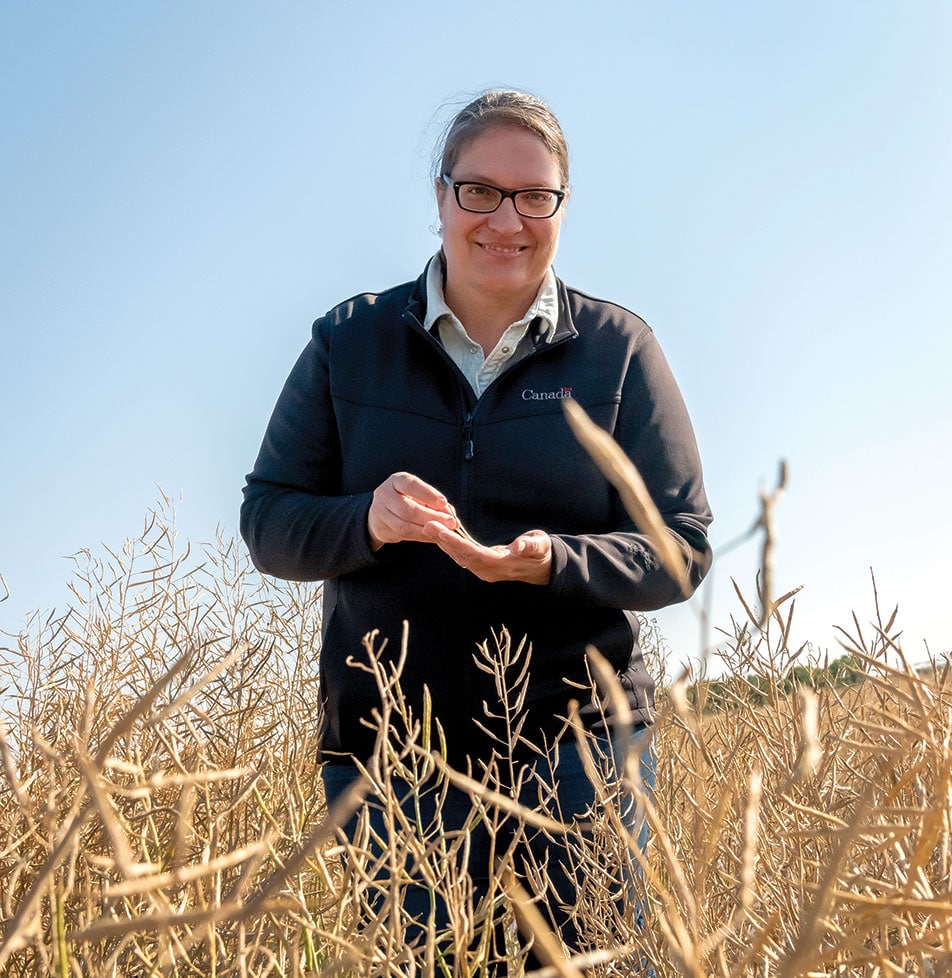
Manipulating recombination in crop polyploids
Principal investigator: Isobel Parkin, AAFC Saskatoon
Funding: SaskCanola, Sask Wheat, National Research Council, Agriculture and Agri-Food Canada
Objectives: To identify homologues of gene candidates controlling homoeologous recombination in wheat and Camelina sativa, to develop constructs for gene knock-outs using CRISPR technology.
Identifying the optimal root system architecture (RSA) for Brassica crops
Principal investigator: Isobel Parkin, AAFC Saskatoon
Funding: SaskCanola, Saskatchewan’s Agriculture Development Fund
Objectives: To understand the level of natural variation of root system architecture (RSA) for Brassica napus, to identify the regions of the genome contributing to variation in RSA and to assess the variation for improving nitrogen-use efficiency.
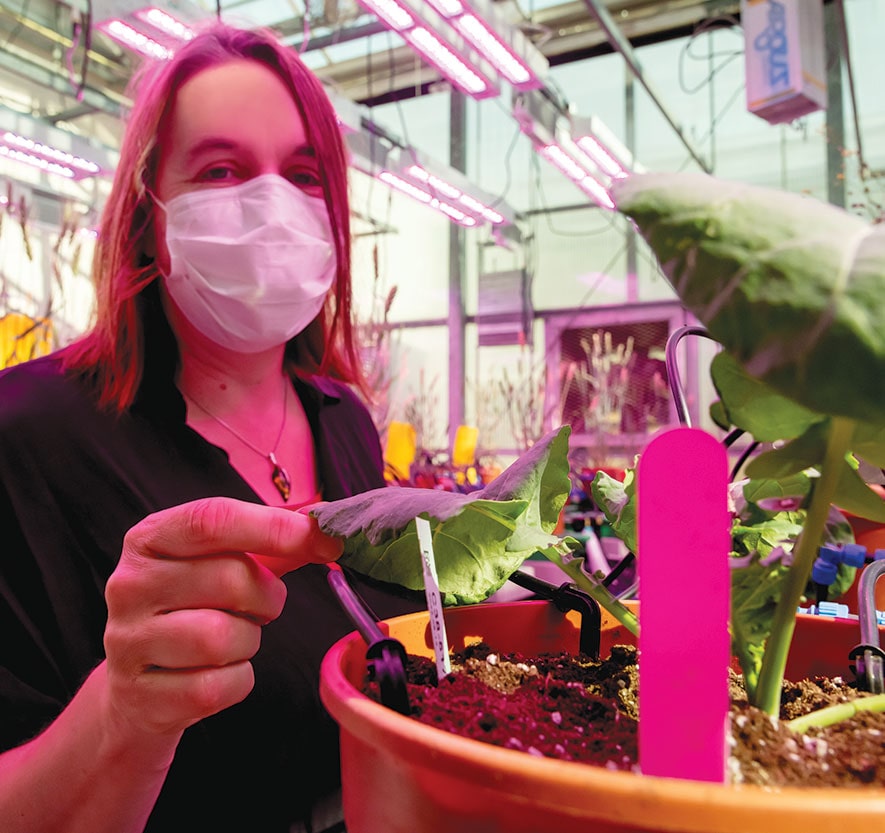
Identification and genetic mapping of novel genes for resistance to blackleg
Principal investigator: Dilantha Fernando, University of Manitoba
Funding: SaskCanola, Alberta Canola
Objectives: To identify and map new sources of blackleg resistance.
Improving blackleg resistance durability through R-gene rotation in commercial fields
Principal investigator: Dilantha Fernando, University of Manitoba
Funding: Canadian Agricultural Partnership
Objectives: To monitor blackleg incidence and severity in selected commercial fields with different R-gene rotations. This will develop empirical data of blackleg avirulence gene changes in the growers’ fields in response to R-gene rotations.
Using avirulence markers to predict the phenotypes of clubroot pathotypes
Principal investigator: Edel Pérez-López, Université Laval
Funding: Alberta Canola, Manitoba Canola Growers, Western Grains
Research Foundation
Objectives: To optimize a hydroponic bioassay to phenotype the interaction between canola and P. brassicae; to identify P. brassicae avirulence markers; to design and implement a multiplex PCR assay able to differentiate P. brassicae isolates.
Building bridges to success – Accessing Brassica diploid variation for Canola improvement
Principal investigator: Steve Robinson, AAFC Saskatoon
Funding: Alberta Canola, Manitoba Canola Growers, SaskCanola
Objectives: To test new technology for blackleg resistance breeding. Domesticated diploid bridging species in combination with targeted diploid germplasm will increase the efficiency to introduce and evaluate new resistance alleles into B. napus.
New clubroot Pathotypes and Second Generation Resistance
Principal investigator: Stephen StWestern Grains Research Foundation
Objectives: To evaluate the infectivity of the most important P. brassicae pathotypes on a suite of canola cultivars with second-generation resistance.






